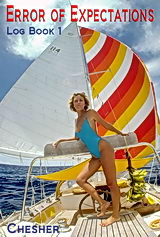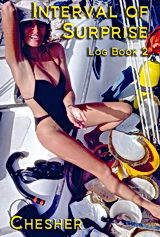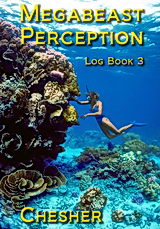Coral Fires Burning
 Another beautiful day in Paradise. Leo is already out
fishing and Walter is concentrating hard on a smoked fish snack. I call Neil Stanton on
the radio and find out he has heard nothing from Port Moresby about the new team or the
new supplies.
Another beautiful day in Paradise. Leo is already out
fishing and Walter is concentrating hard on a smoked fish snack. I call Neil Stanton on
the radio and find out he has heard nothing from Port Moresby about the new team or the
new supplies.
While Freddy rattles around in the galley fixing breakfast I sit in the cockpit and look out at the lagoon. I woke up this morning still thinking about the coral reef, the whole atoll, as a super organism - a megabeast.
"There is a problem, logically, when I try to present the concept of the megabeast to the Earthwatch participants," I mumble.
"Yeah, what's that? Scrambled eggs for brains?" Freddy quips, scrambling eggs.
"No, really. I'm trying to work it out. It's the same logical hurtle needed to comprehend the planet as a living being."
"How can you work anything out before breakfast?" Freddy puts a cup of coffee on the cockpit seat next to me.
There are several ways to look at symbiosis and they have a lot to do with the confusion in my mind about self and community; the individual coral polyp and the whole colony; the one and the many. I glimpsed something on awakening. I scribble some notes in the log:
1) Symbiosis is another name for synergy.
2) Larvae have the same genetic memories as huge coral colonies.
3) Damn! I can't quite focus on the third idea. It was something about direction. To have direction. Something to do with the Gonioporid coral I photographed yesterday. When I touched one polyp, it withdrew. When I touched it again, the whole colony systematically pulled in.
And the dolphins, when one got worried and signaled to the whole school and they left together. When I try to think about it, all I get is the idea of consciousness. The communication of one being with the whole life system.
I know. The third idea is this: Consciousness, the communication network, is a synergetic activity too. Yes. There it is. That's it.
Thoughts, words and biological signals are themselves "beings" made up of the interactive behavior of smaller entities with the larger systems they create - they create with their communications.
The physical manifestation of the signal transmitted along the nerve net of the coral or whacked into the sea by the tail of the dolphin has two aspects.
One: The physical signal itself.
Two: The meaning of the signal to the entities receiving the signal - a meaning defined by the sum total of the memories of the receivers. (To have direction).
"OK, so now I've got it," I say.
"Here's breakfast," Freddy hands it up.
"The layers of the system are created by consciousness (knowing together) - intercommunications between selves sharing the same interval of awareness. Consciousness on one level creates new, different, behavior systems, new levels of being. These new, larger, levels of being then control the behavior of the beings which make them. This gives directionality to the process of becoming - either embryologically or evolutionarily."
"And here's my breakfast," Freddy hands hers up and comes out into the cockpit to eat with me. "Now, what's all this babbling about?"
"The crucial thought is the link between the layers of the nested systems. The control system. It's a feedback control system - a reflection - that changes the direction of the next set of communications. I keep wanting to think of this in cycles, as in cybernetics. But there are no such things as cycles because the whole system is changing its position and relationships in a non-linear and non-repeating way. So the feedback system does not actually feed anything back, but controls the forward systematic development of the communication web "
"Yeah, well, wrap your mouth around those scrambled eggs," Freddy digs in.
" It has to do with the ability of the collective self to perceive, remember, and then, through its sub-layers, respond. But includes the limits of the abilities of its components. It has to do with the...."
"Don't talk with your mouth full," she sips her coffee.
After breakfast we take one look at the clear blue sky and the crystal clear water and grab the camera, dive gear, a picnic lunch and head off to explore.
A sea turtle floats slowly over the shallow sand, sees us and flaps
away at top speed. A tribe of eagle rays majestically glides out of the hazy distance and
wings right past us.
I lie on the bottom, holding my breath, and watch a tiny neon blue goby nip parasites off a goatfish. The goatfish hangs vertically in the water, its long whiskers extended straight out, trying not to flinch as the goby bites off the little isopods clinging to its gill plates. We find a table Acropora almost two meters in diameter cresting a tangled web of living corals of every description. Fish fountain up over the coral and Freddy and I hold hands, just watching.
We eat lunch on the big beach. Leo's boat is nowhere in sight. There is no sign of humanity anywhere except for our dinghy bobbing gently just off the beach. Little ghost crabs dart back and forth on the sand defending their territories or chasing nightmares - who knows. After lunch Freddy cuts my hair and we get into a playful wrestling match, winding up in the water where we abandon bathing suits and pretend we are mating turtles. We both almost drown laughing.
Back aboard Moira and I work on my list again. It's like a cross-word puzzle where the whole pattern adds up to something. I pencil in the letters.
1) Symbiosis = Synergy = To Be.
2) Larvae = Coral Species = To Change.
3) Consciousness = Transmission of Behavior = To have Direction.
The wind comes up. I go outside to see what's happening. Freddy is reading in the cockpit. The sun is setting and the clouds develop a beautiful salmon color. We sit in the cockpit and watch the sun go down. It approaches the horizon and comes into contact with some big cloud banks. I force myself to see the planet spinning so I can feel its majestic, perfect movement as the body of Earth moves up to hide the sun.
"Red skies at night, sailor's delight," Freddy chants. Walter is sound asleep on her lap. I go below, grab my camera and come up to take a shot of the setting sun. At the instant I shoot one of our dolphin friends leaps into the stream of sunlight on the sea. I lower the camera, stunned with joy. There is something about the synchronicity that niggles my neurons. Something special the way the dolphins keep moving into the central focus of my life. Freddy and I watch the dolphins playing in the sunset, enchanted.
When it is dark, I go below, turn on the cabin light over the dinette, and continue with my project.
Corals develop a free swimming larvae called a Planula; a cluster of cells in an oblong shape. The outer cells of the cluster grow flagella. These beat in wave-like synchrony to move the larva through Sea. Coral planula apparently get infected with zooxanthellae after they reach a certain number of cells.
Right. So, here's the idea.
There
is the coral colony, sitting on the sea floor. It is possible
to find other coral colonies of the same species scattered here
and there on the reef. Sometimes there are many colonies of one
kind of coral on a single reef, sometimes only a few, maybe even
only one. If we up anchor and sail down current, to the west,
we would find other coral colonies of the same species here and
there on appropriate substrates, in just the right conditions.
On an ocean wide scale, we call the distribution of all the colonies
of a particular coral species its zoogeographical range.
All the colonies of the same species share the same gene pool. For me, this means they share same memory system because DNA - genes - are memories: memories instructing the cells how to respond to their local environment to create the form of the whole colony. Memories of how to behave to create exact details ranging from microscopic arrangement of skeletal crystals to how the whole massive coral colony forms in differing environmental situations.
To our traditional way of thinking, each coral colony of a species is an individual clump of coral perched here and there on Sea's floor. But in reality, the colonies of the species are linked with each other and with future manifestations of itself, by the little messengers we call planulae larvae. The larvae, with their complete set of coral and zooxanthellae genetic memories, are the same information system, the same memories, but in a different format.
To visualize a coral species, then, I see it not as one coral clump here and one there, but as a field of awareness, a network of memories, extending throughout the geographic range of the coral. The field looks, in the extreme time-lapse vision of my mind, like phosphorescent streams of clouds forming web-like pathways through Sea. Like windslicks, weaving together on the surface of the sea.
The coral colonies bloom where sunlight ripples in the shallow waters, crystallizing from Sea as exquisite manifestations of coral memories, forming shimmering images and rock-hard skeletons where the phosphorescent clouds of larvae touch the sunlit mountain crests of Sea's floor.
In my mental image, the blossoming coral colonies are like fires, burning on the hill tops of the sea, consuming sunlight and sea to create the image of coral flesh. The streams of clouds connecting these solar-flaming coral tissues are a milky way of larvae. Each larva is a sparkling star containing all the evolutionary memories to enable awareness to form a new colony of Goniopora or Acropora.
"Dinner," says Freddy, breaking me out of the vision. I find the break a welcome relief.
I've got the ideas sorted out and can see how they fit together. My mind now sees a coral species not as a symbiosis of two systems existing as scattered clumps of coral, but as a single memory system with many layers of interrelationships existing as a flowing network, laced along a system of ancient circulatory pathways in Sea.
The idea sounds complex when I try to stuff it into words. But in my mind it is exquisitely simple. It dissolves many paradoxes.
The coral colony. The many and the one. A web of communications existing between a multitiered community and its environment. It does not end anywhere, but extends out into Sea, drifting clouds of mind-sparks. Mind-sparks blossom into thought-fires where they brush against conditions that ignite their memories.
Without effort I perceive the genetic memory system evolve from one form to another as it learns to live in the endlessly different conditions of Sea. And this is the third part of the idea. How the layers of the system, ranging from atoms to bacteria to cells to tissues to polyps to colonies to populations to species interlock and control each other. How this leads to non-accidental, non-chance, non-random evolution. The key to the Moirae.
"What's all the thinking about?" Freddy asks. I have eaten half my dinner without even realizing it.
"Corals," I say. "Hey, this fish is really great. I love the sauce."
"I'm getting sick of fish," Freddy holds up a fork-full and looks at it. "What I wouldn't give for a big juicy steak."
"Yeah, me too. But you sure did a good job with this mackerel."
"What about corals?" Freddy asks. "Want some heart of palm salad?"
"Thanks. Ummmmmm. Delicious. What about a huge tossed salad with real lettuce?" I suggest.
"Stop. I'd LOVE a lettuce salad," she groans.
"Anyway, I was thinking about how all the coral colonies of a particular species as well as their larvae interact with Sea."
"And what did you come up with?" She gets up and begins to clear the table.
"I saw them as clouds of sparks - the larvae - the sparks contain the idea of the coral species. A concept of how to grow and live in a certain behavior system, learned over millennia of experience. The spark never goes out and has always burned since it began in the formation of DNA several billion years ago. I see coral colonies like Sea fires burning sea and sun where the sparks alight."
She leans over and looks at my log book filled with pages of scribbles and sketches, "Hmmmm." She is wearing only a wrap-around of bright red cloth with little black men in an island-style pattern. Her breasts come closer and she growls, "How would you like a bust in the mouth?"



